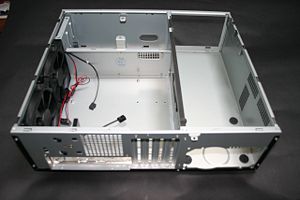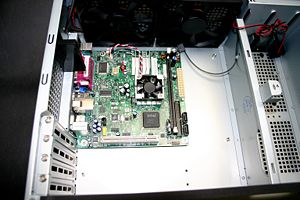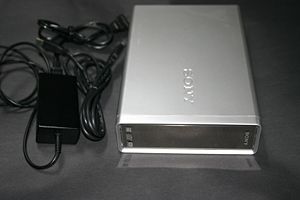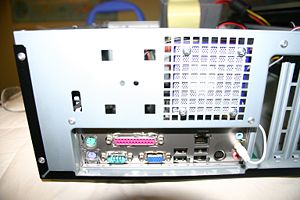Difference between revisions of "A complete HPSDR transceiver"
m (→BNC Cables) |
(→BNC Cables: changed to use commercial cables) |
||
| Line 133: | Line 133: | ||
Total = 15 | Total = 15 | ||
| − | For this many BNC connections, it is essential to have reliable 50 Ohm connections that will stand up to harsh physical use. The best results will be to use | + | For this many BNC connections, it is essential to have reliable 50 Ohm connections that will stand up to harsh physical use. The best results will be to use professionally made instrumentation grade BNC cables rather than buy the tools and learn to make the cables yourself. At Fry's, these quality cables are in the instrumentation section and are branded as "Pomona". From the Pomona data sheet that can be found here: [http://www.pomonaelectronics.com/index.php?i=prodsub&parent=RFCABLE&cat=BCNCABLE&getDetails= Pomona Model 2249 Cable Assembly with BNC Male on Each End]. The advantage over hand built cables are as follows: |
| + | |||
| + | *The molded strain relief is directly bonded to the cable jacket for superior strength and durability. | ||
| + | |||
| + | * Teflon insulation and nickel tarnish resistant outer shells used in the BNC connector provide long life and | ||
| + | reliability. | ||
| + | |||
| + | * Gold plated center contacts assure the most noise free connection possible. | ||
| + | |||
| + | * The connectors and cable are impedance matched. | ||
| + | |||
| + | The length of the Pomona cables are the length in the model number plus 3.37 in or 85.60 mm on each end for the strain relief and connector. The finished 3-D layout will determine number of each length needed. | ||
=== Testing === | === Testing === | ||
Revision as of 10:42, 12 August 2009
An example of a complete HPSDR transceiver using the Mercury, Penelope, and Ozy boards and other available hardware and software. It concludes with test measurements that compare the finished transceiver to other commercially available high end transceivers.
By Ron Cox, W9KFB (with help from the HPSDR group who made all this possible)
Contents
- 1 Specifications
- 2 Enclosure
- 3 Motherboard and CPU
- 4 Memory Module
- 5 Solid State Disk Drive
- 6 External Optical Drive
- 7 OEM Operating System
- 8 HPSDR Components
- 9 Audio Amplifier & Speaker
- 10 Lay Out Components in 3-D Model
- 11 Power usage model
- 12 Install Components
- 13 Wiring
- 14 Testing
- 15 Software Installation
- 16 Optional Software
- 17 Complete Bill of Material (BOM)
- 18 Performance Testing
Specifications
The goal was to build and operate the Highest Performance Amateur Radio Transceiver that can be assembled using components documented on this wiki. Specifically in one case/enclosure, the following is expected:
A totally integrated transceiver with an integrated computer, audio amplifier, speaker, HPSDR components, and 10 to 50 watts of power output. Not included would be the keyboard, mouse, flat panel screen, and antenna tuner. You could compare the proposed rig to commercial rigs such as the Flex 3000, TS-B2000, FT-2000, FT-950, or Ten Tec Pegasus. The transceiver must be mechanically and electrically secure so that one would not hesitate to take one to a field day exercise or a DXpedition as a primary rig.
Enclosure
It may be possible to build the rig in the HPSDR's Pandora's box. It is very possible to do so if you are using a laptop computer and can keep the RF powerout requirements to that needed for narrow band modes such as PSK31 and CW. That rig is being built, but two other rigs that were built came closer to meeting the specifications above. Using this experience, the specification goals will be met.
The following information on the Antec New Solutions Case was taken from their web site at [1]. In looking for a good case to build a transceiver that meets the specifications above and that allows you to access and modify the circuitry without getting in the way, we found that this case meets most of the requirements and delivers many unexpected bonus features. The specific Antec case is a model NSK2480 in the "New Solutions Series". Here are the main selling points about this case and power supply that sells for under $100 USD at most internet suppliers that carry Antec cases:
Power Supply
- The power supply is acoustically quiet and highly efficient.
- The 80 PLUS® Certified EarthWatts 380W power supply is also very quiet electrically and has no detectable switching power supply signals. If any spurious signals are detected in testing, we will eliminate them using clamp-on ferrites.
- Universal input (100 - 240 volts at 6 Amps with 50 or 60Hz). This power supply must power all the HPSDR components that we put in this case.
Case Structure
- 0.8 mm cold-rolled steel construction
- Triple-chamber structure to isolate power supply and amplifier heat for cooler & quieter operation
- 4 Drive Bays are used for HPSDR components, no optical or hard drives will be mounted here
The internal HDD trays are removed to allow room for HPSDR components (see photo).
- 4 Expansion Slots - Only two will be usable as expansion slots because we will only use a Mini-ITX motherboard
- Front-mounted ports for easy mike and earphone connections: 2 x USB 2.0 (example: Griffin Knob and/or USB DSP headset); Audio in and out (analog mike and headset)
- Unit Dimensions: 5.5" (H) x 17.5" (W) x 16.3" (D); 13.97cm (H) x 44.5cm (W) x 41.4cm (D)
The height of the enclosure makes it possible to mount the HPSDR Atlas, Mercury, Ozy and Penelope boards.
Cooling Design
- Advanced cooling system: 2 side mounted 120 mm TriCool™ 3-speed fans
The fans really only cool one of the three chambers, the one with the computer mounted in it, but they are very low noise when set at low or medium speeds.
Motherboard and CPU
From experience building several HPSDR transceivers in this case, we have found that all is needed is a small footprint Mini IPX motherboard. No extra I/O cards are required if one uses virtual software ports. By using SATA drive ports exclusively we can use such a small motherboard. A intel DQ45EK Desktop Board was ordered for this project, but a better lower cost solution is to use the new Intel D945GCLF2 board with a Dual-Core Intel Atom Processor and Integrated Graphics. A test of running PowerSDR on this processor resulted a CPU usage of less than 30%!
Memory Module
The Intel D945GCLF2 board will only work with up to 2 GB of 667MHz single module speed memory. The cost was $28.99 USD with a $10 USD mail-in rebate.
Solid State Disk Drive
This item is optional to some extent, but you will need a mass storage device of some type to operate the software. For years this has been the trusty (??) hard disk drive. The capacity of hard drives has increased from 20 MB in the late 80s to over 1TB 1,0000 GB or 1,000,000 MB today. New on the computer scene is the Solid State Disk Drive, an all electronic drive that communicates via the same SATA type cable as the SATA disk drives. We use the drive to save space in the case. Shock mounted disk drive(s) take even more space. The Drive used for two previous builds of this design is the Patriot 32GB drive. It will be mounted on one of the case bay walls. Other than the space savings, these drivers read faster and consume less power and generate less heat than the mechanical drives. The cost of a 32 GB SSD drive is a reasonable $109.00USD
External Optical Drive
This facility is used to load programs but there is not enough room in the case for the drive. It is seldom used and a thumb drive is a good substitute for just copying and transferring programs from one computer to another. Sony makes a nice matching portable drive that several hams are using with this HPSDR transceiver as needed via a USB2 cable. The Sony model number is DRX-840U (see photo). Cost is $99.99.
OEM Operating System
The only way to buy an operating system for a new system like this is to purchase the OEM version. Most internet stores should carry it. To be compatible with most of the popular HPSDR software, Windows XP home edition works. Amazon.com lists " Microsoft Windows XP Home Edition SP2B for System Builders [OLD VERSION] by Microsoft Software (CD-ROM) (Windows XP) Buy new: $86.91 2 Used & new from $86.91"
HPSDR Components
| Part Name | Price ($US) |
|---|---|
| Atlas Kit- TAPR | 35.00 |
| Mercury RX - TAPR | 329.00 |
| Penelope TX - NT-Electronics | 357.54 |
| Ozymandias- TBD | TBD |
| Alexiares - TAPR | TBD |
| PennyWhistle - TAPR | TBD |
| 100 Watt 160 M to 6 M Amplifier - TBD | TBD |
Audio Amplifier & Speaker
The issue of how to best add an audio amplifier & speaker to a computer/HPSDR rig has been unresolved for some time. We now have a good solution. Normally the Mercury board's line out will be connected directly to the computer's line input. If one wanted amplification, for example in a noisy environment, then an audio power amplifier with appropriate power level would be used. Per the specifications the HPSDR transceiver we are designing and building must have an internal speaker component. A good small speaker with a battery powered amplifier was purchased at Fry's Electronics. It is called the iCube distributed by I_Concepts, and it cost $3.90 USD. The iCube was modified to run on 5 Volt computer power by putting a 5 volt computer style connector on it and using a 10 uf and .01 uf cap in parallel across the power input to the iCube to reduce the low level noise. The ICube was mounted to the cold rolled steel cabinet back with 4 sheet metal screws (see photo).
Lay Out Components in 3-D Model
A model of the Antec NSK2480 is being drawn using Google SketchUp 7 for the Mac and PC. If anyone has SketchUp models of the components listed so far, they could be used in this effort. We will attempt to model or collect models of all the listed components and make them available to all HPSDR transceiver builders.
Power usage model
Here we will track power usage by each Component for wire and connector sizes and power supply loads.
Install Components
Key Jack and Key Wiring
Microphone Jack and Wiring
Wiring
BNC Cables
In thinking ahead of what we are going to need for wiring this HPSDR transceiver, one set of items stand out as essential, BNC cables. First lets count the number of BNC connections in this rig:
1. Mercury 1
2. Penelope 1
3. Alex 9
4. PennyWhistle 2
5. 100 Watt Amplifier 2
Total = 15
For this many BNC connections, it is essential to have reliable 50 Ohm connections that will stand up to harsh physical use. The best results will be to use professionally made instrumentation grade BNC cables rather than buy the tools and learn to make the cables yourself. At Fry's, these quality cables are in the instrumentation section and are branded as "Pomona". From the Pomona data sheet that can be found here: Pomona Model 2249 Cable Assembly with BNC Male on Each End. The advantage over hand built cables are as follows:
- The molded strain relief is directly bonded to the cable jacket for superior strength and durability.
- Teflon insulation and nickel tarnish resistant outer shells used in the BNC connector provide long life and
reliability.
- Gold plated center contacts assure the most noise free connection possible.
- The connectors and cable are impedance matched.
The length of the Pomona cables are the length in the model number plus 3.37 in or 85.60 mm on each end for the strain relief and connector. The finished 3-D layout will determine number of each length needed.
Testing
Software Installation
All software listed here excluding Fldigi is for Windows systems only. Other software is under development for other operating systems see: HPSDR related software
PowerSDR
For installation instructions go to the Quick Startup Guide and scroll down to "PowerSDR Software Installation", then follow the directions given there.
KISS Konsole
You must try this program as it was written to be a simple interface to the Mercury and Penelope boards. You can find information on downloading and operation at KISS Konsole.
com0com
This program is required to allow programs to communicate frequency , mode, CW and PTT data. It is required software that must be installed to operate the digital modes using Fldgi. Go to [2]to learn about and install com0com.
Virtual Audio Cable
Other than the operating system, this is the only program that is listed on the BOM that must be purchased. The trial version might be used to get familiar with the program, but it is not usable on the air. With out this program you would have to use your built in sound card and external cables which can pick up RF signals. It is a much cleaner installation to use this program. Cost $39.99 USD. Go to this website to purchase and download [3].
Fldigi
This program is required to get operating on digital modes. Follow the recommended settings given below and you should not have any problems. First install the program per the instructions on this web site [4].
Optional Software
CW Skimmer
Complete Bill of Material (BOM)
| Part Name | Price ($US) |
|---|---|
| Antec NSK2480 Case and power supply | 100.00 |
| Intel D945GCLF2 Motherboard & CPU | 84.99 |
| Corsair DDR2 2GB PC3500 memory module | 19.99 |
| Solid State Disk Drive 32GB | 109.00 |
| External Optical Drive Sony DVD/CD Rewritable Drive Model DRX-840U | 99.99 |
| Microsoft Windows XP Home Edition SP2B for System Builders | 86.91 |
| Virtual Audio Cable | 39.99 |
| iCube Portable Speaker | 3.90 |
| HPSDR Components | 721.54+TBD |





